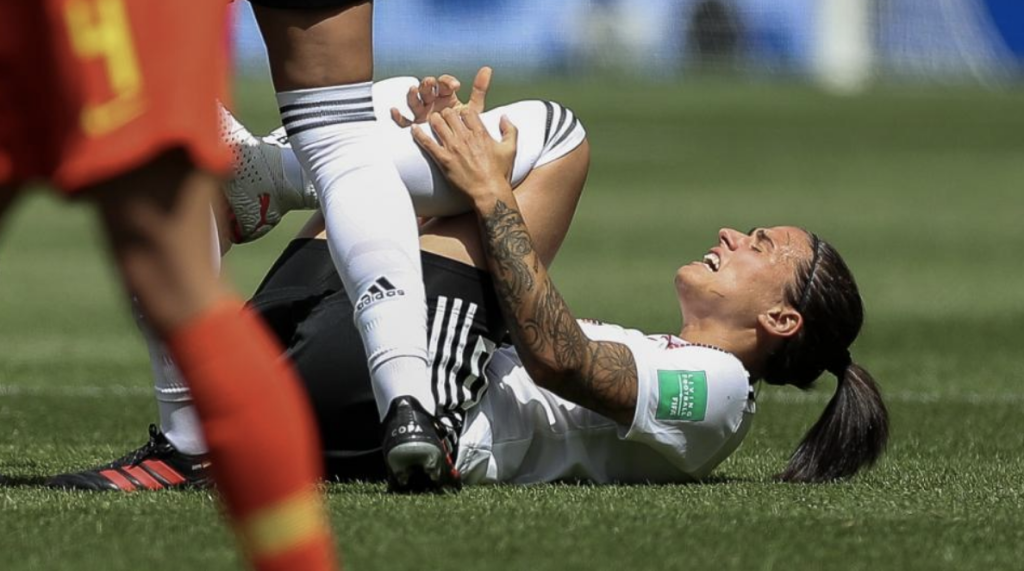By Imani Adesanya
On Sunday, October 15th, Arsenal forward and England star, Beth Mead made an appearance on the football pitch for the first time in 11 months. She was substituted on in the 87th minute and was met with a large roar from over 30,000 Arsenal fans in attendance at the Emirates Stadium. Arsenal were losing 0-1 when she came on and assisted the winning goal in the fourth minute of stoppage time. Her quality showed even in the few minutes she was on the pitch, reminding people of what Arsenal and England had been missing for so long.
But what caused her to miss such a substantial amount of time? The answer is a tear in her anterior cruciate ligament (ACL). Beth Mead is just the first of four Arsenal Women’s players to return from an ACL injury picked up from last season. Leah Williamson, Vivienne Midemma and Laura Wienroither also suffered the same fate and are yet to return to the pitch. And this injury isn’t confined to Arsenal, across the women’s game there have been many ACL injuries, vastly affecting the FIFA Women’s World Cup. Between 25 and 30 players were unable to compete in the Women’s World Cup earlier this year because of ACL tears. This high volume of injuries has raised concerns and led to demands for more research on ACL tears, specifically in women’s football.
ACL injuries are also prevalent in the men’s game, but the sheer volume in women’s football has made them a more salient issue. Research shows an ACL tear is one acute injury that female athletes are two to eight times more likely to experience than males. Women tear their ACLs at an alarmingly higher rate, and so, more should be done to strengthen the welfare of female players. One could pose the question of whether more attention and research would go into this issue, if it was as prevalent in men’s football as it is in women’s.
But what is an ACL injury and why are they more common in female footballers? The ACL is a tough band of tissue joining the thigh bone to the shin bone at the knee. It runs diagonally through the inside of the knee, providing joint stability. It also helps control the back-and-forth movement of the lower leg. A tear in the ACL can lead an unstable knee and loss of full range of movement. Players who get these injuries can be out for up to 9 months. The longevity of the injury not only has implications for players physically, but also imposes serious mental constraints. The fear of not being able to return to previous levels of play can dwell on players’ minds, making it one of the worst and most feared injuries in football.
This fear is felt more in female players because they are at a greater risk. One reason is anatomy. The male and female anatomy are different: females have a wider pelvis, which changes the mechanics of how the thigh bone, tibia, and femur function. This puts more stress on the soft tissues that support your joints, explains Dr Gardner. Higher stress can lead to either a chronic (overuse) or acute (sudden) injury. Also, women have less muscle mass around their knees compared to men, says Samantha Smith, MD, and “That, too, can lead to instability and a higher chance of tearing a ligament if it is overstretched.” It has also been suggested that hormones play a role in making women more at risk. Women on average have less testosterone than men, a key hormone for increasing muscle density. Women also have much more oestrogen on average than men, which is important for bone growth and fluctuates during the menstrual cycle. Oestrogen may cause greater laxity (looseness) in tendons and ligaments, making women more prone to injury.
Another factor that could indirectly increase risk for female footballers is gender inequality, which is still prevalent in football. There is more investment in men’s than women’s football: female players do not always have access to good facilities and rehabilitation. This has negative implications, as it makes players more vulnerable to injury. Another external factor, highlighted by Dr Okholm Kryger is that football boots are designed for men, meaning women may face issues because the way they move is different to men. For example, the length of studs on boots are designed around male movement, which increases the risk of women getting their boots stuck in the surface, causing injury.
Since the Lionesses success at Euro 2022, the demand for women’s football has been at an all-time high. Match attendance is on the rise and more football shirts with women’s players on the back are being purchased. However, the research surrounding ACL injuries and injuries in general needs to catch up with the game so that players can be better protected. Another target for women’s football is equality of access to resources: this includes coaching and medical resources, as well as access to facilities. The growth of women’s football has been incredible to witness, but to boost the women’s game, more work must be done.
Photo from FootballBlog.co.uk



